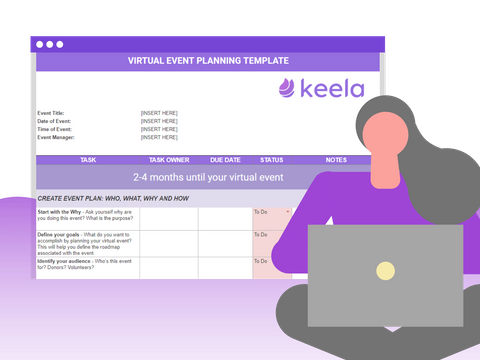The Complete Guide to Online Fundraising Ideas


As a nonprofit staff or volunteer, you work day in, and day out, solving all kinds of problems to ensure that you can continue making a difference.
Staffing, paperwork, even building maintenance, and office supplies are essential to your nonprofit’s services to the community. But nothing is more important than the foundation of every nonprofit: fundraising. Without the generous support from concerned citizens, your organization’s efforts would just be good intentions. Donations allow you to turn those intentions into actions that benefit the world.
Online fundraising is rapidly becoming the bedrock strategy of savvy nonprofit marketers. This study notes that online revenues grew by 23% in 2019, compared to 15% the year before. All signs point to this trend continuing as people become harder to reach by phone, mail, or in person.
If digital fundraising isn’t already a part of your overall strategy, or if you’ve dabbled but not made it the focus of your revenue stream, it’s time to adapt to a changing marketplace.
What is Online Fundraising?
Simply put, online fundraising is the process by which nonprofit organizations solicit and collect donations via the internet. There are various tools and strategies available to digital fundraisers, from donation forms and social media campaigns to virtual fundraising events and donation matching.
These tools do double duty for your nonprofit organization. They provide compelling opportunities for engaging with donors and meeting supporters at the most convenient place: their email inboxes, social feeds, and often in the palms of their hands. While the sheer number of online fundraising options available to you may seem overwhelming, the truth is digital fundraising simplifies the process for your donors, and that’s always a good thing.
Why is Online Fundraising Important?
According to a survey of global donors, 54% of donors prefer to give online, which means we’ve reached a tipping point. More than half of your audience is probably not interested in receiving mail or phone calls anymore, and that percentage will get more significant year after year.
On top of that, 56% of donors visit nonprofit websites via mobile devices and tablets instead of desktop computers. Yet only 3% of charities rate their board and executive leadership as being digitally savvy. Is your organization ready to prioritize its online experience?
Donors are moving in a clear direction, but a lot of nonprofits have been slow to follow. This same survey found that 66% of charities are worried they will miss out on digital fundraising opportunities. Worrying about it is okay, but why not do something about it?
What are the Benefits of Online Fundraising?
Besides the global trend toward a preference for online fundraising methods, your organization also has specific benefits.
1. Reach More Donors
There has never been a faster, easier, and cheaper way to distribute information in human communication history than the internet. Add to that the fact that links and content can be shared at the click of a button, and it’s easy to see that reaching more donors in less time is a reality that online fundraisers can enjoy.
In terms of demographics, online fundraising also allows you to reach the world’s largest generation of supporters: millennials, who give to charity on a considerable scale (84%) and outnumber even the baby boomers. They also prefer to give online, often via smartphone.
2. Boost Your Donor Engagement
Raising money online isn’t just about getting those benjamins. It’s also about providing value to your supporters, interacting with them, and building long-term relationships that create a positive impact.
Online tools like social media, virtual events, and email are great at capturing your followers’ hearts and minds. Email response rates are increasing, which means that the spampocalypse is waning and people are beginning to trust again; that is, your recipients are pretty likely to read your emails. And that’s good for business.
3. Gather Important Donor Insights
Sure, you might get a donation from a snail mail campaign, but will you learn anything from it? Probably not, at least not compared to online tactics.
Everything you do to raise money digitally, even if it fails, teaches you something about your audience. Capturing data lets you understand your audience better and make adjustments to your campaigns so that next time you can blow the doors off your fundraising goals. Keela’s smart tools capture information from donation pages and emails to automatically generate insight into your donors.
4. Online Fundraising Is Cost-Effective
Gone are the days of having to pay a designer, a printer, and a bulk mailing company to get your fundraising information out to potential supporters. The internet has made it possible for nonprofits on a shoestring to mount professional campaigns with a laptop and a lot of caffeine.
Digital tools allow you to apply your efforts to multiple channels, meet donors where they are, capitalize on trends, and stay nimble in the face of a changing media landscape. With Keela, you get all the online fundraising tools you need in a single subscription — no nickel and diming, no constant requests to upgrade, so you can budget reliably and still have access to the very top-of-the-line technology.
11 Online Fundraising Ideas to Try Now
Now more than ever, your nonprofit needs to implement a digital fundraising strategy to be competitive. We’ve compiled some easy online fundraiser ideas to get you started
1. Send Fundraising Emails
Email is the workhorse of any digital fundraising strategy; it’s responsible for one-third of online fundraising revenues and earns $40 for every $1 spent, the highest return of any marketing channel. And it makes sense: rather than a scattershot approach like advertising or handing out flyers on the street, email reaches people in their homes or on their phones and can be personalized to each recipient. Email also drives views on other platforms, pushing users to your website and your social media channels.
Crafting a successful fundraising email isn’t just taking a shot in the dark—there are best practices that will guide you toward success, the most important of which is telling a good story. This is the crucial advantage of sending an email: it gives you the flexibility to deliver a compelling narrative that can forge a bond with your audience and build an actual relationship. People who feel more connected to your cause are more likely to give.
Like your donation page, keep your email simple, short, and with a clear call to action. Don’t overwhelm the reader with links to outside sources, multiple messages, low contrast buttons, or anything else that distracts them from your goal. Tell your story, then make your ask. When your reader clicks through, your well-optimized donation page takes over.
For an in-depth look at email marketing, check out Keela’s Complete Guide to Nonprofit Email Marketing. You may also consider structuring your email campaign as a peer-to-peer fundraiser.
Getting Started
The most straightforward way to get going on an email campaign is to build a template. A template gives you a consistent look and layout, which provides a sense of continuity and can enhance your brand when sending more than one email. And in all likelihood, you’re going to be sending a lot of emails. In 2017, on average, nonprofits sent 66 email messages per subscriber. You don’t want to reinvent the wheel every time you send an email.


Perfect Thank You Letters
We know creating a thank you letter or email from scratch can be a challenge. We have created 7 customizable templates to thank donors, volunteers, sponsors, and more!
2. Add A Donation Form To Your Website
As the last thing, people see before they make the jump from a visitor to a donor, donation forms are the most crucial element in your online fundraising strategy. While a donation form isn’t exactly a “fundraiser” in the traditional sense, it is one of our best online fundraising ideas for nonprofits because it affects virtually every other online fundraiser that you might plan.
There are plenty of tweaks you can make to your existing donation form or dedicated donation page; or, if you’re building one from scratch, take a look at these best practices and example pages to guide you. Either way, an optimized donation form will boost:
- Average donation amount
- Conversion from visitor to new donor
- Recurring donations
- Returning donors
Donation forms plugged directly into your CRM, as they are in Keela, also help you gather donor data in a streamlined way to customize future campaigns. Here are a few things that will help your donation form work harder for your nonprofit:
a. Keep it Simple
This study found that 40% of nonprofits require non-essential information to complete a donation. Why put roadblocks between you and your donors?
Make your donation form as straightforward as possible: write a clear message that shows the value that your nonprofit contributes to the world, try not to clutter the page, and make the donation button easy to see.
b. Social Proof
Demonstrating that donors are part of a broader community helps encourage them to give in ways that benefit your organization. For example, “Make a monthly donation” is a lot less compelling than “Join our community of 1,285 monthly supporters.” If visitors can see a groundswell of support for your cause, they will be more likely to give.
c. Nudges
Sometimes all it takes is a little push in the right direction. Nudges are small features used to direct attention to specific actions or encourage visitors to give more. For example, even though 54% of nonprofits don’t pre-select a preferred giving amount, putting a default number in the donation amount field is a great way to help people decide to give an amount that is beneficial to your nonprofit.
Likewise, if your form offers amount options of, say, $10, $25, $50, and $100, highlighting the $25 option will bring in more $25 donations and potentially convince $10 donors to give more.
Getting Started
Keela is a great way to get your online fundraising program off the ground. It’s easy to use and offers a suite of tools to help you get the most out of your customized donation form before you dive into your next digital fundraiser. Using Keela, you’re able to streamline all of your donation processes, including processing donations, issuing tax receipts, and following up with a thank you email – all with just a few clicks. You can get started with only one click here.
3. Use a Text-to-Give Fundraising Tool
More people spend their time on mobile devices than they do on desktops or watching television. Mobile devices are a part of our daily lives; they help us communicate and connect easily. With text-to-give fundraising tools, nonprofit organizations can leverage the power of mobile communication to do more good.
With over 50% of donors accessing nonprofit websites via mobile browsers, text-to-give fundraising tools allow donors and supporters to donate via text. They can do this by texting a keyword to a phone number and charging the donation amount to their phone bill. These mobile donations are useful because they reduce the hurdles that usually stand in donors’ way, and they widen the nonprofit’s reach.
Using a text-to-give fundraising tool doesn’t take anything away from other fundraising efforts. It works perfectly with your fundraising emails and donation forms on your website. These mediums give your donors options and make your fundraising campaign accessible.
Getting Started
Through texts, donors can give from anywhere and at any time. You should make the giving experience as seamless and smooth as possible. Use text-to-give fundraising tools like OneCause and QGiv to set up text-to-give fundraising campaigns that allow donors to give through their phone’s native text messaging application.
4. Launch a Planned Giving Campaign
What’s better than one donation? Recurring donations, the gift that keeps on giving! Recurring donors can be the ongoing lifeblood of your organization, and launching a campaign that converts one-time donors into recurring donors or encourages recurring donors to renew their commitment can be extremely rewarding.
With an average annual donation total for recurring donors of $326, compared to $128 for one-time online donors, it’s easy to see the difference a recurring commitment can make. Plus, more than half of millennial donors prefer to give monthly instead of a large, one-time donation. But how do you get donors to leap to giving every financial quarter or even every month?
First, give them the option. Make sure your donation page not only has the option to give recurring gifts but also highlights that option, or even defaults to that option if you’re feeling bold. Second, work on cultivation throughout the year. Be sure to communicate with your donors, letting them know the good that their donations do. Thank them.
Don’t always ask for a donation; sometimes, an email with news or information can do just as much to encourage recurring donations as an email that asks directly. And thank them. Then, thank them again. Did we mention thanking them?
Getting Started
The best way to get started is to go back and read number one above. Writing a great email is the way into your recurring donors’ hearts. Whether you’re asking one-time donors to commit to monthly giving, asking recurring donors to renew their pledges, or just sending good news from your nonprofit, make sure you’re telling a great story. Beyond that, make sure your donation forms are set up to receive monthly donations—Keela makes it easy to do.
5. Organize Virtual Fundraising Events
While it’s nice to gather all of your supporters in one place for a big fundraising event, it’s not always feasible. If you’re reaching many people by email or social media, there’s a solid chance that they aren’t all located in the same place. By hosting a virtual event, you can still get the feeling of camaraderie and community spirit that you would expect at a live event, driving donations, and further support for your cause.
What’s a virtual fundraiser? Well, think of the sorts of events that you might host in person and now imagine them, you guessed it, online!
In 2020, the number of organizations hosting virtual events doubled, so your audience is likely aware of them and probably primed to attend. You can move galas, award shows, concerts, film festivals, art exhibitions, and more online to accommodate large and far-flung audiences. Plus, virtual events are perfect for peer-to-peer fundraising. They help you access your hardcore supporters’ networks.
Getting Started
Just like any fundraising event, the success of a virtual event comes down to proper planning. You’ll need a good team. It should include at least one person who is well-acquainted with the necessary technology to stream or otherwise distribute your content.
And on that note, get your tech in order long before your event starts: if you’re using video conferencing software like Zoom, test it beforehand. Try your best to host everything via hardwired internet rather than wireless; it’s one less thing that can hiccup during your event.
And, of course, get your donation page ready, so that event attendees can go through a streamlined giving experience when they decide to give. You can even use Keela to create a custom donation form that is specific to your event.


Nail your event with this planning template
We created a planning template to guide you every step of the way towards organizing a virtual event from scratch.
6. Plan an Online Games Tournament
Like virtual events, online games tournaments are a fantastic way to capture an audience that is already rabidly committed to one element of your event: video games! As we write this, ESPN is holding a tournament pitting real NBA superstars against each other on NBA2K20, with the winner receiving $100,000 to give to the charity of his choice. And it’s nationally televised!
While network media coverage is probably not realistic for the average nonprofit organization, there are dedicated web services, like Twitch, that make streaming video games easy for both the tournament organizers and viewers. Just set up your stream, set a donation amount as an entry fee for competitors, and encourage viewers to give to your cause as a way of supporting their favorite players. In 2019, Twitch raised over $55 million for charity using methods like these, so don’t hesitate to get in on the action.
Getting Started
If you haven’t played video games in a few years, your best bet before deciding on a game is to ask a kid. Popularity ebbs and flows, so even though Fortnite is hot right now, it might not be in six months when you hold your tournament.
Get familiar with Twitch or your chosen streaming service, then promote your event far and wide to build an audience by the time the puck drops (assuming you’ve selected a hockey video game). And make sure you optimize your donation page or custom donation form like you did for virtual events.
7. Organize an Online Auction
Charity auctions aren’t a new concept. Every bike ride for a cause or gala dinner includes a silent auction laid out on banquet tables near the bar. And there is a good reason for their inclusion: people like them. They like the thrill of bidding, the electricity of anticipation, the relief when someone else wins the vibrating massage chair, because seriously, where were you going to put that thing?
Auctions translate beautifully to the web. No more booking conference rooms, collecting prizes all in one place, or occupancy limits. You can invite as many people as you want, offer a wide range of items for bidding, and raise funds all from the comfort of your home or office.
Getting Started
Kick off your online auction planning by selecting a platform, such as 32auctions, that gives you easy tools to get your items posted and bidders bidding. After that, it’s just like any other auction: find sponsors, write up prize descriptions, and promote it on social media, your email lists, and local media outlets. You’ll also need to decide if your auction is standalone or part of a larger event.
Once your auction is over, be sure to follow up with winning bidders to make it crystal clear that they won, that they now need to pay up, and discuss how the item will be delivered. As with everything else in the nonprofit world, don’t forget to say thank you.
8. Use the Facebook Fundraiser Tool
If your nonprofit has a lot of Facebook followers, a Facebook Fundraiser may be an easy and accessible way to raise money online. Globally, 18% of donors have given to fundraisers using this tool, and a large share (84%) of Facebook users are likely to show their support for a cause, allowing your brand to capitalize on their desire to share. Facebook Fundraisers may also gain you followers, which can be beneficial for later campaigns.
Getting Started
Start here and brush up on the requirements for this type of campaign. Canadian users should note that donated funds will have to go through PayPal. Before you start, make sure you have the staff capacity to respond to comments and questions promptly, and as with virtually everything else on this list, don’t forget to tell a great story!
9. Run a Donation Matching Drive
What if you could double the amount of every donation you receive with just one ask to an individual or organization? You can, with donation matching.
Donation matching pairs a large donor with hundreds or even thousands of small donors to double the total amount of donations given. Find a large single donor (corporations are often a good place to start looking), then offer your supporters the opportunity to have their donations matched dollar for dollar.
It’s a straightforward concept with a lot of great benefits. Supporters are 84% more likely to donate to a matching campaign, and just mentioning matching can lead to a 71% boost in response rate and a 51% average donation increase. People see donation matching in much the same way as they see social proof (see above): other people, and their money, are on board with the same cause, so it feels like a better, safer investment.
Donation matching adds value to many of our online fundraising ideas for nonprofits. The most obvious is email campaigns since email gives you the space to explain how it works and who the matching partner is. That said, matching works via social media, too.
Maybe you’ve planned an online campaign that doesn’t seem to be getting quite as much traction as you expected. Find a partner and start offering donation matching to kick your campaign up a notch.
Getting Started
Find a matching partner before you can start this type of fundraiser. Look for large donors who already support your nonprofit, prominent and wealthy individuals known to support nonprofit work, and corporations with similarly aligned values.
Finding a matching partner is just the beginning. An under-promoted matching campaign can leave a lot of money on the table: anywhere from $6 billion to $10 billion in matching funds go unclaimed every year when fundraisers fail to find supporters. So go back and brush up on your email fundraising skills, tell a great story, cultivate your email lists with helpful information and interesting news, and when you get a donation, thank, thank, and thank again.
10. Run a Crowdfunding Campaign
Until recently, nonprofits have traditionally looked for a few large donors to back their cause. With the advent of the internet, collecting smaller donations from dozens, hundreds, or thousands of donors became possible. Often confused with peer-to-peer fundraising, a crowdfunding campaign directly invites donors to come to your nonprofit and give what they can. Peer-to-peer is similar, but nonprofits use evangelists and ambassadors to ask on their behalf rather than directly soliciting donations.
Crowdfunding is great because it’s relatively simple. Create a donation page with a compelling message, then share it on social media and via email and ask everyone who sees it to share as well. One link leads back to your donation page and donation form, where you reap the rewards.
Getting Started
Before you start wildly sharing your message, think carefully about how it is going to be received. This survey found that crowdfunding campaigns with video raise 150% more money than those without video. Nonprofits with many social media followers tend to be more likely to succeed, and nonprofits that update their followers receive 126% more donations.
So if you just have one low-quality photo, 29 Twitter followers, and are too busy to post updates, this might not be the method for you. Also, it’s time to admit that you don’t want to be on Twitter anymore.
Once you’re ready to plan your crowdfunding campaign, start by choosing a platform like GoFundMe or IndieGogo. Pay close attention to the fee that these services charge and make sure that it fits your financial model. Customize your fundraising page in a way that tells a compelling story and highlights your brand. Use photos and videos to connect emotionally with potential donors.
In your donation form, always offer several suggested donation amounts; remember, even small donors make a big difference to crowdfunding campaigns. For each donation tier, decide if you will be offering a gift incentive.
When your campaign is set up and ready to run, promote the heck out of it everywhere you can: social media, the local paper, e-newsletters, etc. While it’s happening, provide regular updates to interested supporters and encourage additional sharing. And when it’s all over, say thank you, of course!
11. AmazonSmile
AmazonSmile is a program that gives a percentage of Amazon sales to nonprofits. When you register with Smile and supporters shop via smile.amazon.com, they can select your nonprofit organization to receive 0.5% of eligible purchases. It’s not a lot of money, but once you’ve set it up, it requires very little input from you and doesn’t cost your supporters any extra on purchases they were going to make anyway.
Since there is no such thing as a free lunch, not everyone agrees that this program is good news. So before getting started, ensure that you are well-informed about the pros and cons of AmazonSmile.
Getting Started
If you understand the small print, the best and only way to get started is at org.amazon.com.
What to Do After a Successful Fundraising Campaign
So you’ve run a successful campaign. Thousands of people around the world supported your cause, and your nonprofit’s bottom line is secure. Time to relax, right? Not so fast.
If you refer back to your handy donor journey map, you’ll realize that there are still a few things you need to do.
1. Say Thank You
We said it before, in this post and virtually everywhere else, but it bears repeating: thank your donors! Donors who receive personal and specific thanks are more likely to give again. So when you launch your next fundraiser, they’ll still be there to support you.
2. Re-Ask
Just because you asked for a donation and someone gave doesn’t mean they won’t give again. With enough time between asks, it can’t hurt to drop another one into your next email communication or social media post.
3. Collect Emails
Since email is an effective way to raise funds, always collect email addresses and segment them into relevant lists. It’ll be a boon for future campaigns, we promise.
4. Do Your Research
Knowing who your donors are, what they care about, and when and how much they might help you make educated decisions about what kind of fundraiser to run, and when to make it happen. Keela uses artificial intelligence to reveal more about your supporters, taking the guesswork out of fundraising.
5. Make it Easy
Put yourself in the shoes of your donors. Find yourself tripping over something? They’re going to trip too, and every stumbling block between the donor and your donation page is one less gift toward a cause that makes a difference.
Above all else…
Remember that you need to go to where your donors are to stay competitive in a rapidly changing world of technology. Tactics that have worked in the past may not do the job in the future, so it’s vitally important that your organization pivots in a way that prioritizes fundraising methods that reach out to donors rather than expecting them to come to you. So warm up your typing fingers, fire up your fastest router, and take your wildest ideas to the web!
See How Nonprofits Use Keela to Collect Online Donations
Get a glimpse of how Keela’s fundraising smart tools help nonprofit organizations to strategize, streamline, and automate their fundraising efforts.


